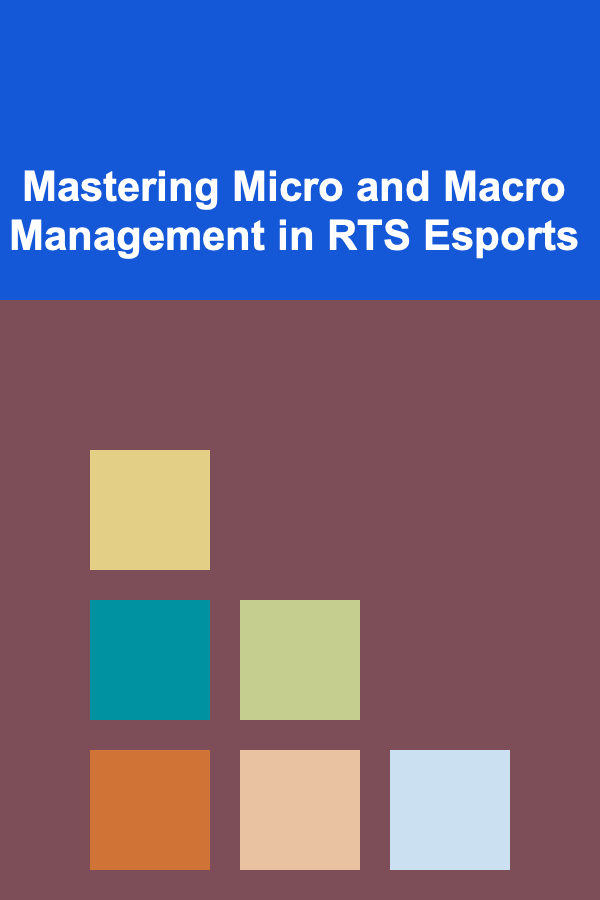
Mastering Micro and Macro Management in RTS Esports
ebook include PDF & Audio bundle (Micro Guide)
$12.99$5.99
Limited Time Offer! Order within the next:

Real-Time Strategy (RTS) esports are among the most demanding and intellectually stimulating competitive gaming genres. Success in these games requires a complex interplay of strategic vision, tactical prowess, and the ability to efficiently manage resources and units under pressure. Two key elements underpin a player's skill in RTS: micro-management (micro) and macro-management (macro). While distinct, they are intrinsically linked, and mastering both is crucial for achieving top-tier performance.
Understanding Micro-Management: The Art of Precision
Micro-management, at its core, involves controlling individual units or small groups of units with exceptional precision during engagements. It's about maximizing the effectiveness of each unit, minimizing losses, and exploiting opponent weaknesses through skillful maneuvering and ability usage. Think of it as the tactical battlefield command, the moment-to-moment decision-making that can turn the tide of a battle.
Key Aspects of Micro-Management:
- Unit Positioning and Movement: Proper positioning is paramount. This includes kiting (maintaining distance while attacking), flanking (attacking from the side or rear), and utilizing terrain advantages like high ground or choke points. Effective movement minimizes damage taken and maximizes damage output. For example, in StarCraft II, kiting with Marines against Zealots can significantly reduce Marine casualties. Knowing the range of your units and your opponent's units is critical here.
- Target Prioritization: Identifying and focusing fire on high-value targets is essential. This might involve eliminating enemy healers, focusing down key damage dealers, or targeting units vulnerable to specific attacks. The optimal target prioritization changes dynamically based on the composition of both armies and the flow of the battle.
- Ability Usage: RTS games often feature units with unique abilities. Mastering the timing and application of these abilities is crucial. Whether it's casting a healing spell, using a stun, or deploying a defensive shield, effective ability usage can dramatically impact the outcome of a fight. This requires understanding the cool-down times, mana costs, and ranges of each ability.
- Minimizing Unit Losses: Protecting vulnerable units and withdrawing damaged units from the front lines is a critical aspect of micro. This might involve using tank units to absorb damage, strategically retreating weakened units to be healed, or utilizing defensive structures to provide cover. Experienced players will instinctively know when to commit to a fight and when to disengage.
- Exploiting Unit Strengths and Weaknesses: Understanding the specific strengths and weaknesses of each unit type is fundamental to effective micro. This involves using units that counter the opponent's composition and avoiding unfavorable engagements. For example, in Age of Empires II, archers are strong against infantry but vulnerable to cavalry, so effective micro would involve keeping archers protected from cavalry charges.
Techniques for Improving Micro-Management:
- Practice Drills: Dedicated practice drills focusing on specific micro techniques are invaluable. These drills can involve practicing kiting, splitting units to avoid area-of-effect attacks, or perfecting ability usage. Custom game scenarios or training maps are excellent for this purpose.
- Replay Analysis: Reviewing your own replays (and those of professional players) is a powerful tool for identifying areas for improvement. Pay attention to your unit positioning, target prioritization, and ability usage. Ask yourself why you made certain decisions and how you could have played the situation better.
- Hotkeys and Control Groups: Using hotkeys and control groups is essential for rapid unit selection and control. Memorizing the hotkeys for frequently used commands and assigning units to control groups allows for quick and efficient maneuvering during intense engagements. The faster you can react, the better your micro will be.
- Minimap Awareness: While focused on micro, maintaining awareness of the minimap is critical. This allows you to anticipate enemy attacks, reinforce vulnerable positions, and coordinate attacks across the map. Develop the habit of glancing at the minimap frequently, even during intense engagements.
- APM Training: While Actions Per Minute (APM) is not the sole determinant of skill, it does reflect a player's ability to execute commands quickly and efficiently. Practicing actions like building units, gathering resources, and issuing commands can help improve APM, which in turn can enhance micro-management capabilities. Focus on effective APM, though. Spamming unnecessary commands is not helpful.
Understanding Macro-Management: The Grand Strategy
Macro-management focuses on the broader aspects of the game, encompassing resource management, base development, technology research, and army composition. It's about planning and executing a long-term strategy to gain a decisive advantage over the opponent. Think of it as the overall war strategy, the economic and technological engine that fuels your army.
Key Aspects of Macro-Management:
- Resource Gathering: Efficient resource gathering is the foundation of any successful RTS strategy. This involves optimizing worker allocation to different resource nodes, expanding to new resource locations, and defending resource gathering operations from enemy harassment. Knowing the optimal number of workers per resource node is critical (e.g., three workers per mineral patch in StarCraft II).
- Base Expansion and Development: Expanding your base network allows you to gather more resources and produce more units. Strategic base placement is crucial, taking into account resource availability, defensive chokepoints, and proximity to the opponent. Defending expansions is also paramount.
- Technology Research: Investing in technology upgrades enhances your units' capabilities and unlocks new unit types. Prioritizing research based on your strategy and the opponent's composition is essential. For example, researching armor upgrades can significantly improve the survivability of your units against certain attacks.
- Army Composition: Building a balanced and effective army composition is critical for success. This involves understanding the strengths and weaknesses of different unit types and creating a composition that can counter the opponent's forces. Scouting and adapting your composition to the opponent's strategy is essential.
- Production Capacity: Maintaining a high production rate is crucial for keeping up with the opponent and overwhelming them with superior numbers. This involves building enough production structures and managing your resources to ensure a constant flow of units. Understanding the production cycle times of your units is important for optimizing your production.
- Scouting and Information Gathering: Gathering information about the opponent's base, army composition, and technology is essential for making informed decisions. Scouting with early units and utilizing detection units to reveal cloaked or burrowed units is critical for anticipating enemy attacks and adapting your strategy.
Techniques for Improving Macro-Management:
- Build Orders: Learning and practicing build orders is a fundamental aspect of macro-management. Build orders are pre-planned sequences of actions that optimize resource gathering, base development, and unit production in the early game. Many resources are available online that detail build orders for various RTS games. Understanding why a build order is effective is more important than simply memorizing it.
- Spending Efficiency: Maintaining a low resource float (unused resources) is a key indicator of good macro-management. Aim to spend your resources as quickly as you gather them, ensuring that your production facilities are constantly producing units and your research is progressing. The "supply blocked" message is a macro player's worst enemy.
- Control Grouping for Production: Assigning production structures to control groups allows for quick and efficient unit production. This enables you to produce units across multiple bases simultaneously without having to manually select each building.
- Creep Spread (Zerg Example): In StarCraft II's Zerg race, spreading creep provides vision, movement speed bonuses, and allows for faster tumor placement. Effectively managing creep spread is a crucial aspect of Zerg macro.
- Periodic Base Checks: Regularly check your bases to ensure that your resource gathering is optimal, your defenses are adequate, and your production facilities are functioning properly. This habit can prevent costly mistakes and ensure that your economy is running smoothly.
- Minimap Awareness (Again!): Even when focusing on base management, never forget the minimap. Spotting enemy movements, potential attacks, or expansions early allows you to react proactively and defend your assets.
The Symbiotic Relationship: Micro and Macro Working Together
Micro and macro are not mutually exclusive skills; they are complementary aspects of RTS gameplay. Effective micro-management can compensate for a weaker economy in the short term, while strong macro-management provides the resources and technology necessary to sustain a long-term advantage. A skilled RTS player seamlessly integrates both micro and macro, constantly shifting their focus between the tactical battlefield and the strategic overview.
Examples of the Interplay:
- Early Game Harassment: Effective micro of a small raiding party can disrupt the opponent's economy, delaying their expansion or technology research. This buys you time to develop your own economy and army.
- Defending Expansions: Skilled micro of defensive units can hold off an early enemy attack on a newly established expansion, allowing you to secure a vital resource location.
- Trading Efficiently: Good micro in engagements allows you to inflict more damage and take fewer losses, effectively "trading" your units for the opponent's in a more favorable ratio. This translates to a resource advantage over time.
- Exploiting Macro Mistakes: A scouting report reveals your opponent neglected building more production facilities. With adept micro, your smaller, more mobile army can deliver devastating blows to key production locations before reinforcements arrive, capitalizing on their strategic lapse.
Balancing Micro and Macro: The Key to Consistent Performance
Finding the right balance between micro and macro is a challenge that every RTS player faces. Too much focus on micro can lead to neglecting your economy and falling behind in resource gathering and technology. Conversely, too much focus on macro can leave your units vulnerable to skillful micro-management by the opponent.
Strategies for Finding the Right Balance:
- Prioritize Based on Game State: In the early game, macro-management is typically more important as you focus on establishing your economy and building your base. As the game progresses and engagements become more frequent, the balance shifts towards micro-management.
- Delegate Tasks: In team games, players can specialize in different aspects of the game. One player might focus on macro-management while another player specializes in micro-management. Clear communication and coordination are essential for this strategy to be effective.
- Automate Tasks: Utilize game features like auto-casting spells or automated unit production to free up your attention for other tasks. This allows you to focus on micro-management during engagements without neglecting your macro-management.
- Practice Switching Focus: Consciously practice switching your focus between micro and macro. Develop the ability to quickly assess the situation on the battlefield, make tactical decisions, and then return your attention to managing your base and economy.
- Build Muscle Memory: Through consistent practice, develop muscle memory for common macro tasks like building units, expanding, and researching upgrades. This frees up your mental bandwidth for more demanding micro-management tasks.
Game-Specific Considerations:
While the fundamental principles of micro and macro management apply to all RTS games, the specific techniques and strategies vary depending on the game's mechanics and unit design. It's crucial to understand the nuances of each game and adapt your approach accordingly.
Examples in Different Games:
- StarCraft II: Micro-management in StarCraft II often involves splitting units to avoid area-of-effect attacks, kiting with ranged units, and using spells like Force Field or EMP to control engagements. Macro-management focuses on expanding quickly, maintaining a high supply count, and scouting the opponent's base.
- Age of Empires II: Micro-management in Age of Empires II involves raiding with light cavalry, managing siege units, and protecting vulnerable villagers. Macro-management focuses on balancing resource gathering, upgrading units, and building a diverse economy.
- Company of Heroes: Micro-management is absolutely vital in Company of Heroes due to the cover mechanic. Flanking enemies to remove their cover bonus is essential. Proper weapon team facing is another key aspect of micro. Macro primarily focuses on resource acquisition and unit choices based on available resources and strategic objectives.
Beyond the Basics: Advanced Micro and Macro Techniques
Mastering micro and macro is an ongoing process that requires continuous learning and refinement. As you become more experienced, you can explore advanced techniques to further enhance your gameplay.
Examples of Advanced Techniques:
- Multi-Tasking: Effectively managing multiple engagements simultaneously is a crucial skill for high-level RTS players. This requires the ability to quickly assess different situations, issue commands, and then switch your attention to another engagement.
- Mind Games and Deception: Using feints, fake attacks, and other deceptive tactics to mislead the opponent and gain a strategic advantage. This can involve pretending to attack a certain location, only to strike elsewhere, or hiding your true army composition.
- Timing Attacks: Launching attacks at specific moments in the game to coincide with a vulnerability in the opponent's defense or a critical technology upgrade. This requires careful planning and timing, but can result in a decisive victory.
- Map Control: Controlling key areas of the map to deny resources to the opponent, secure strategic chokepoints, and gain a positional advantage. This involves utilizing scouting units, establishing forward bases, and deploying defensive structures.
- Economy Denial: Raiding your opponent's economy with fast units like Reavers or Mutalisks in Starcraft II to cripple their income and limit their ability to produce units.
The Mental Game: Maintaining Focus and Composure
RTS esports can be incredibly stressful and demanding, requiring intense focus and quick decision-making under pressure. Maintaining composure and avoiding tilt (becoming emotionally upset and making poor decisions) is essential for consistent performance.
Strategies for Improving Mental Fortitude:
- Practice Under Pressure: Simulate tournament conditions by playing practice games against challenging opponents or participating in online tournaments. This will help you develop the ability to perform under pressure.
- Develop a Pre-Game Routine: Establish a consistent pre-game routine to mentally prepare yourself for competition. This might involve reviewing strategies, visualizing successful engagements, or listening to calming music.
- Take Breaks: Avoid burnout by taking regular breaks from practicing and playing. Step away from the computer, relax, and engage in activities that you enjoy.
- Learn from Losses: Don't dwell on losses, but instead use them as opportunities to learn and improve. Analyze your replays, identify your mistakes, and develop strategies to avoid repeating them in the future.
- Positive Self-Talk: Replace negative thoughts and self-doubt with positive affirmations. Believe in your abilities and focus on your strengths.
Conclusion: The Path to RTS Mastery
Mastering micro and macro management in RTS esports is a challenging but rewarding journey. It requires a combination of technical skill, strategic thinking, and mental fortitude. By understanding the principles of micro and macro, practicing diligently, and continuously learning from your experiences, you can steadily improve your gameplay and climb the ranks of competitive RTS. Remember that improvement is a marathon, not a sprint. Consistency, dedication, and a passion for the game are the keys to long-term success.

How to Make Moving Less Stressful for Children
Read More
How to Set Up a Filing System for Important Papers
Read More
How to Use Your Car to Make Money
Read More
How To Understand Human Resources for Small Businesses
Read More
How to Learn Ice Hockey (Extreme Skating)
Read More
How to Handle Holidays and Special Occasions During Weight Loss
Read MoreOther Products

How to Make Moving Less Stressful for Children
Read More
How to Set Up a Filing System for Important Papers
Read More
How to Use Your Car to Make Money
Read More
How To Understand Human Resources for Small Businesses
Read More
How to Learn Ice Hockey (Extreme Skating)
Read More